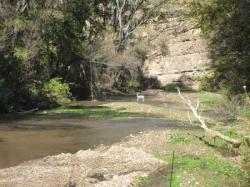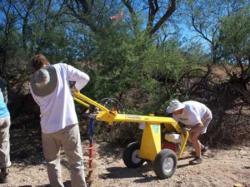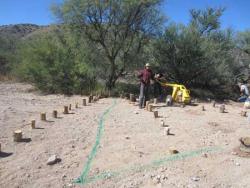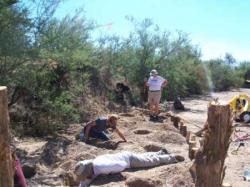Putting the Kinks Back in Streams
 By Nathan Jackson (originally appeared in the Southwest Environment, a publication of the University of Arizona)
By Nathan Jackson (originally appeared in the Southwest Environment, a publication of the University of Arizona)
A white-tailed deer doe and fawn stop for a mid-day drink in Aravaipa Creek less than a half-mile downstream from Cobra Ranch. Photo by Nathan Jackson A white-tailed deer doe and fawn stop for a mid-day drink in Aravaipa Creek less than a half-mile downstream from Cobra Ranch. At The Nature Conservancy’s Cobra Ranch in southeastern Arizona, Van Clothier led a band of volunteers from both the U.S. and Mexico in a project to restore Stowe Gulch, a streambed that is dry most of the year but flows into Aravaipa Creek a few times a year during rain events.
On a brisk October morning, about a dozen volunteers from the Tucson-based Sky Island Alliance and the Cananea Institute of Technology just across the border gathered around area maps while stream restoration expert Van Clothier and Mark Haberstich, preserve manager, explained the natural history of the creek and surrounding land.
Cobra Ranch resides right at the mouth of Aravaipa River, where year-round water flowed higher up the canyon as recently as 50 years ago, said Haberstich, who managed the TNC’s neighboring Aravaipa Canyon Preserve since 1996 and Cobra Ranch since 2007. The previous owner, Dan Bates, donated the ranch to TNC under the condition that the land becomes part of the Aravaipa Canyon Reserve.
A damaged stream Decades of cattle overgrazing and roads running across the creek bed contributed to stream damage, Clothier said.
“When we got it, there wasn’t a lot of perennial grass on the ranch and there were a lot of erosion problems,” said Haberstich, “Almost all of the tributary canyons coming into Aravaipa Canyon had erosion problems and had become channelized.”
Since then, TNC reduced livestock grazing from about 150 to 20 head of cattle– while placing primary focus on restoring the land.
 Volunteers use an auger to break up soil. On this October day, through the cooperation of non-profit groups, agency employees and volunteers, Stowe Gulch took its first step towards returning to a natural, winding and healthy stream. After evaluating the water system, Clothier determined that this would require putting some of the kinks back in the stream. The goal was to do this by installing in-stream creek deflectors to direct the stream flow.
Volunteers use an auger to break up soil. On this October day, through the cooperation of non-profit groups, agency employees and volunteers, Stowe Gulch took its first step towards returning to a natural, winding and healthy stream. After evaluating the water system, Clothier determined that this would require putting some of the kinks back in the stream. The goal was to do this by installing in-stream creek deflectors to direct the stream flow.
This basically consisted of digging dozens of holes in strategic locations determined by Clothier, who painted a wedge-shaped grid in the sand to serve as guidelines for the location of posts that would soon become deflectors.
The drive motor of the mechanical auger provided by BLM fired up. Under the instruction of Clothier and BLM volunteer Jeff Conn, volunteers used the auger to create pilot holes in the sand. The auger proved helpful to break up the soil but inevitably the sand fell back into place after removing the auger bit.
The remainder of volunteers picked up their shovels and dug out the holes as the auger progressed down the row. The sand tended to fall back into the holes as the shovel handles brushed the edge at greater depths, requiring the volunteers to remove the last of the loose material by hand. How deep to go?
"Volunteers clean sand from the holes to prepare them for the juniper posts.“As deep as you can reach to clean out with your arm,” said Conn as he laid belly down to clean the sand from a hole.
Cooperative efforts The Bureau of Land Management and TNC have worked together in co-management of Aravaipa Creek. Haberstich said a study by Neuman and Adar in 1983 estimated Stowe Gulch drainage area contributed about 40 percent of the water flow to the headwaters of Aravaipa Creek.
Arizona is quite dry during most of the year and relies on sporadic heavy rains for most of its water. During these heavy rain events, even streams that are dry the rest of the year can experience heavy streamflow. Clothier said that the posts must be deeply seated, with holes at least 3 feet deep. Otherwise the force behind the water flow would wash them away after debris collected in the baffle.
Volunteers placed juniper posts in each hole and the packed dirt around them. The posts will collect debris and sediment over time. They will serve as a skeleton, in effect,  providing a support system for the meandering stream bank that will develop.
providing a support system for the meandering stream bank that will develop.
Van Clothier demonstrates proper post seating depth. These new sections of bank alternating from one side of the channel to the other along the stream will increase the sinuosity to a more natural state. Sinuosity, as defined by Clothier in his book, is the “wiggle factor.”
The benefits of meandering Putting these kinks back into the system increases the length of the channel. A stream that “wiggles” back and forth travels a longer course as it moves through the valley than it would in a straight line. A longer, meandering stream means the water spends more time on the land, allowing the earth to soak it up to recharge the underground layer of water below that feeds Aravaipa Creek.
The volunteers followed their leader with tools in hand, pouring hours of sweat and labor into the construction of induced meandering structures. In spite of the language barrier that existed, volunteers quickly fell into rhythm with one another as they followed Clothier’s guidance. The collaborative effort by non-profit TNC, the BLM agency and public volunteers aid in the preservation of this stream – which includes one of the Southwest’s most intact native fisheries – in the face of uncertain future climate.
Volunteers put the final touches on a nearly finished section of the creek deflector project. “The main value of the Cobra Ranch to us was that it is really important for supplying flow to Aravaipa Creek,” said Haberstich, “so I wanted to do everything I could to encourage better infiltration.”
The second stage of what Haberstich deemed a “two-step restoration process” was well underway. Haberstich has seen the restoration through from the beginning. In the first stage of the restoration, he increased ground cover by planting native grasses that stabilized the soil to combat the extensive erosion throughout Stowe Gulch.
The next step, according to Haberstich, was to address the problem the incised channel of Stowe Gulch. In his search for a solution, he was directed by the Quivira Coalition to a book they had published written by Bill Zeedyk and Van Clothier called Let the Water Do the Work. The book detailed methods developed by the authors to induce meandering and restore stream channels to their natural winding courses.
It just so happened that Haberstich and Clothier shared a common friend in Jeff Conn of BLM. Conn put a call in to Clothier and the project hit the ground running.
And so began the difficult task of designing a restoration plan for Stowe Gulch. Quoting his mentor, Zeedyk, Clothier said you have to become a “forensic hydrologist.” To understand the disturbances, you have to look at all the clues on the landscape.
“If it’s not beautiful, you can bet it’s not natural,” Clothier said, “A stream will quickly recover if the project aims to help the stream move toward a more natural state.”
Nathan Jackson is majoring in Natural Resources: Wildlife Conservation and Management. He plans to further his studies in wildlife management and engage in large mammal research. This story was submitted for publication on December 18, 2012.


